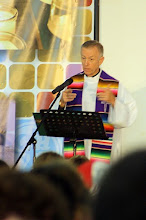An abbreviation frequently seen in Roman funerary monuments is DM, Diis Manibus, an invocation to the gods of the lower world, asking for gentleness and mercy for the person whose remains are in this spot (I write in this way because for most of the first centuries after Christ pagan Roman practice typically was cremation). Christians, it turns out, adopted this shorthand as well—evidently it had become so much a standard (I almost said cliché) that its pagan meaning was pretty well dissolved.
Another inscription often seen is DOM, Deo Optimo Maximo—to God the greatest and highest. Originally this was a title for Jupiter in the Roman pantheon of deities. A temple to Jupiter under this title was built on the Capitoline Hill in Rome. This site is very near to the location of the huge white marble monument to Vittorio Emmanuele II, which also bears tribute to the “Unknown Italian Soldier” with its eternal flame and honor guard (much like Arlington National Cemetery).
Again, Christians had no problem adopting this title for the Judaeo-Christian God, and it was sometimes also applied to Christ, when the translation offered was Domino Optimo Maximo, to the Lord (Jesus) as opposed to God in the "pure" sense).
Of much greater familiarity to most of us is the famous RIP, Requiescat In Pace, may he/she rest in peace. In translation it is used as a significant part of the Rite of Commendation in Catholic funerals.
All of this leads me to a slight twist, for this past Sunday I spent a good part of the late morning and early afternoon in cemeteries in Chicago. I always say that visiting here is not typically what I do first, but it is always “Job 1” on my list of things to do. The drill is very simple: I bring flowers, and I go to Fairmount first because it is nearer. There are my Mom’s parents’ and my sister-in-law’s parents’ graves. I trim the grass around the headstones, wash them a bit, place the flowers, and pray commendation prayers for each of them. Then I head to Resurrection, where most of my Dad’s family is buried. But I go to my parents’ and baby brother’s graves. I perform the same ritual, but with an addition: I open up a lawn chair, facing the graves and under a tree, and pray a Rosary for them. And in all the times I’ve done this (six years now) this is the moment of greatest peace for me. And in this sense I live the RIP on the headstones with another meaning—it is the peace promised by Jesus in the “Farewell Discourse” of John’s Gospel, the peace the world cannot give, the peace we are to offer each other before we receive the Lord in the Eucharist at Mass.
In whatever way, I hope everyone can find a special place of peace to rest in sometimes. It is the goal of all retreats, after all, and Jesus understood this need. After the disciples returned from a missionary expedition, He said to them, “Let’s go away by ourselves and rest for a while.” Of course it didn’t work out that way for Jesus (crowds followed), but He understood (and understands) what is important. I am glad that I have such places to go to sometimes, but Resurrection Cemetery is far and away the place where I can best “rest in peace,” even if only for a couple of hours.
This is a "companion piece" of sorts to the post previous; it is also on the "Pastor's Corner" portion of the parish's web-site: www.oursaviorparish.org. Check out that site for different bits of writing.

The spiritual communion and love expressed for your family is a
ReplyDeletebeautiful one. It is an example which can only lead one to acceptance
and peace when one is faced with this transition of a loved one from life
to death.